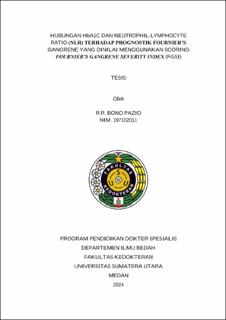| dc.description.abstract | Introduction: Fournier's Gangrene, a life-threatening necrotizing fasciitis, primarily affects individuals over 50 years old, with risk factors including diabetes, alcoholism, and urogenital instrumentation. This study investigates the relationship between Hemoglobin A1c (HbA1c), Neutrophil-Lymphocyte Ratio (NLR), and the prognostic implications for Fournier's Gangrene, using the Fournier's Gangrene Severity Index (FGSI) for assessment.
Methods: A cross-sectional, correlational analytical study utilized secondary data from medical records at RSUP H. Adam Malik from January 2015 to July 2023, focusing on the correlation between HbA1c, NLR, and FGSI scores in Fournier's Gangrene prognosis.
Results: Out of 100 samples, high HbA1c and NLR levels were significantly associated with worse FGSI scores, indicating a poorer prognosis for Fournier's Gangrene. Statistical analysis revealed a moderate correlation between HbA1c levels and FGSI scores and a weak correlation for NLR, considering their prognostic significance.
Discussion: The findings affirm the critical role of HbA1c in monitoring glycemic control and its direct correlation with Fournier's Gangrene severity, suggesting the necessity of effective diabetes management. Similarly, NLR's association with inflammation severity underscores its utility in prognostic assessment.
Conclusion: Elevated HbA1c and NLR levels are significant predictors of adverse outcomes in Fournier's Gangrene, with HbA1c being a more robust prognostic indicator compared to NLR. | en_US |


